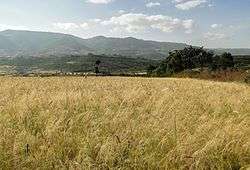Mojo, Ethiopia
Mojo (also transliterated as Modjo) is a town in central Ethiopia, named after the nearby Modjo River. Located in the Misraq Shewa Zone of the Oromia Region, it has a latitude and longitude of 8°39′N 39°5′E with an elevation between 1788 and 1825 meters above sea level. It is the administrative center of Lome woreda.
Mojo ሞጆ | |
|---|---|
Town | |
 A tef field near Mojo. | |
 Mojo Location within Ethiopia | |
| Coordinates: 8°39′N 39°5′E | |
| Country | Ethiopia |
| Region | Oromia |
| Zone | Misraq (East) Shewa |
| Elevation | 1,788 m (5,866 ft) |
| Population (2008) | |
| • Total | 49,521 |
| Time zone | UTC+3 (EAT) |
Overview
Mojo is not only accessible by road (a road connecting the town to Adama was built before the Italian conquest) but has been the location of a train station of the Addis Ababa - Djibouti Railway since the line was extended from Dire Dawa to Akaki in 1915. With the railroad, Mojo also gained telegraph (later telephone) service and a restaurant to serve travelers.[1] Modjo now has a dry port. [2]
Population
Based on figures from the Central Statistical Agency in 2005, Mojo has an estimated total population of 39,316 of whom 19,278 were males and 20,038 were females. [3] The 1994 national census reported this town had a total population of 21,997 of whom 10,455 were males and 11,542 were females.
History
The earliest mention of Mojo is in the Futuh al-Habasha, which mentions that Imam Ahmad ibn Ibrihim al-Ghazi burned a village named "Masin" and a church belonging to the Emperor prior to the Battle of Shimbra Kure; at the time, Mojo was part of the former province of Fatagar.[4]
In June 1965, construction of the Ethio-Japanese Synthetic Textiles Mill began, with a budget of 15 million Birr. The Textiles Co. behind it was 49% Japanese and 51% Ethiopian owned, with a capital of 2.5 million Birr. The company formally introduced its products to the market at the beginning of August 1966; the factory went into 24-hour operation in December 1966 and had 152 looms. On 30 October 1996, an Ethiopian Air Force aircraft crashed into the marketplace, killing 8 people and injuring 94. About 50 residential and commercial buildings were destroyed by fire.[5]
References
- Richard Pankhurst, Economic History of Ethiopia (Addis Ababa: Haile Selassie University, 1968), pp. 293, 334, 339f
- http://www.xinhuanet.com/english/2018-03/25/c_137064573.htm
- CSA 2005 National Statistics, Table B.4
- Sihab ad-Din Ahmad bin 'Abd al-Qader, Futuh al-Habasa: The conquest of Ethiopia, translated by Paul Lester Stenhouse with annotations by Richard Pankhurst (Hollywood: Tsehai, 2003), p. 60
- "Local History in Ethiopia" (pdf) The Nordic Africa Institute website (accessed 26 November 2007)